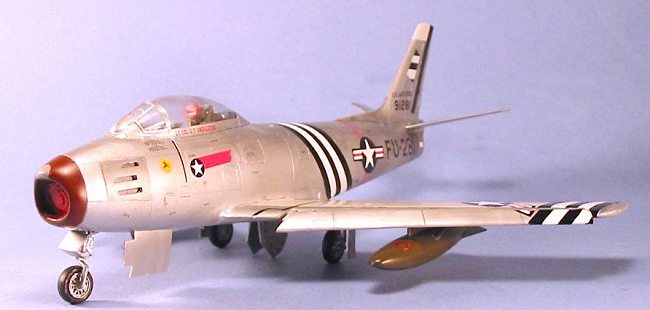
|
KIT # |
? |
|
PRICE: |
Over $100.00 for the kit, decals, cockpit set, and conversion set |
|
DECALS: |
See Review |
|
REVIEWER: |
|
|
NOTES: |
Cutting Edge conversion set ($41.99) and decals ($10.00) used. Jaguar F-86 cockpit set also installed. Designed for Hasegawa kit but will work with Academy one just as well. |

|
HISTORY |
It is very likely that
the world's first supersonic aircraft was not the Bell X-1 research aircraft,
but rather the North American XF-86A. The first prototype, 45-59597, had been
completed in August 1947, powered by a Chevrolet-build J-35-C-3, producing 4,000
lbs. thrust. It was trucked from North American's Inglewood factory at Los
Angeles airport to Muroc on September 10, 1947. North American's test pilot,
George Welch, took the airplane for a first flight on October 1, 1947, during
which time he had trouble getting the nose wheel to lock down for landing; after
40 minutes spent trying unsuccessfully to
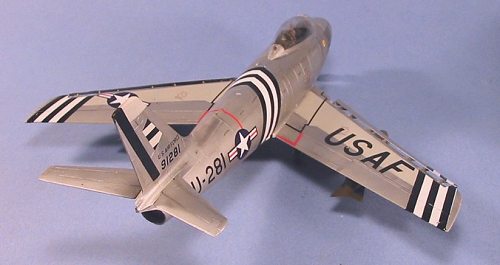 get the nose wheel to lock down, Welch
landed nose high and the impact of landing jogged the nose wheel into place.
According to the official history books, that was the only flight undertaken
that day.
get the nose wheel to lock down, Welch
landed nose high and the impact of landing jogged the nose wheel into place.
According to the official history books, that was the only flight undertaken
that day.
Rumors abounded for years that the XP-86 had flown a second time that day, and that Welch had exceeded the speed of sound in a 5,000 foot dive. The Air Force has always stuck to the official story, given their attachment to the history that says an Air Force test pilot named Chuck Yeager was the first man to fly faster than the speed of sound, but nearly everyone involved with North American at the time - several of whom I met out at Planes of Fame during the 1980s - stated flatly that Welch did fly a second time and that a sonic boom was heard. Given that the Sabre was definitely capable of exceeding Mach 1 in a dive, and did it on numerous occasions over MiG Alley in later years, this could well be true. Welch was certainly a pilot who would take a prototype to maximum performance quickly; when he took the first XF-100 up on its first flight, he went supersonic within 20 minutes of takeoff.
At any rate, the Sabre does not need to add this to the very long list of achievements that made it the finest fighter of its generation and one of the great combat aircraft of history.
The Sabre almost
didn't happen. Had the Air Force not been willing to delay the F-86 program
while North American undertook to study the swept wing research done by
Messerschmitt during World War II, the F-86 would have been a straight-winged
airplane with a performance approximating the F-84 Thunderjet, and history would
have been very different had that F-86 entered combat against the MiG-15 over
Korea. Development of the Sabre was "just right," with its first flight
in 1947 coming within months of the unknown Russian
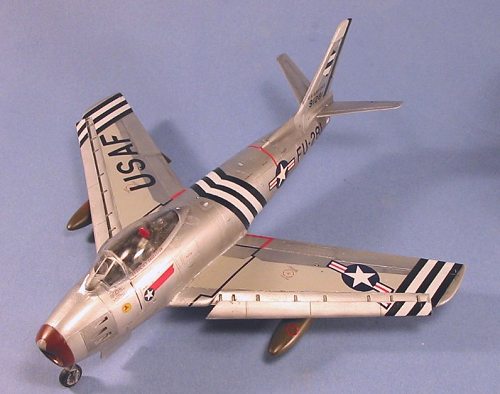 prototype it would meet a
few years later, there were no major "bugs" to be worked out for production, and
the airplane entered squadron service a year before the outbreak of the Korean
War.
prototype it would meet a
few years later, there were no major "bugs" to be worked out for production, and
the airplane entered squadron service a year before the outbreak of the Korean
War.
With the entry of the MiG-15 into combat over Korea in November 1950, it became imperative that the F-86 be sent to Korea since the MiG was vastly superior to everything else the Air Force had in-theater. The veteran Fourth Fighter Group was sent to Korea, and flew its first combat mission by the middle of the month. That December of 1950, the 4th Fighter Interceptor Wing - descendants of the American Eagles of the RAF and the top-scoring U.S. fighter group of World War II - arrived in-theater, equipped with the most advanced U.S. fighter, the superb North American F-86A "Sabre." By the middle of the month, it had been established that the Sabre could take on the MiG-15 with confidence both from equipment and flying ability of the pilot. The next two and a half years would see air battles between outnumbered Sabres and MiG-15s over "Mig Alley," which was basically the northeastern quarter of North Korea from just north of the capital at Pyongyang to the Yalu River.
While the Sabres proved their superiority over the MiG when it was flown by Chinese and North Korean pilots, when the U.S. fighter went up against MiGs manned by Russians who were also veteran aces of the Second World War - as were many U.S. Sabre pilots - it was a different kettle of fish. The Russians of the 324th IAD (the first unit to enter combat) were commanded by no less that COL GEN Ivan Kozhedub, with 62 victories the Allied Ace of Aces of the Second World War; in fact, we now know that the Ace of Aces of the Korean War was not 16-victory ace Captain Joseph McConnell of the 51st FIW, but rather COL Yevgeny Pepelyaev, CO of the 196th Guards Fighter Regiment, a fierce believer in the adage "train hard, fight easy" who strove "to meet the American standard" with his pilots. During his 6-month tour in 1951, Peplyaev claimed 23 of the 104 victories scored by the 196th IAP.
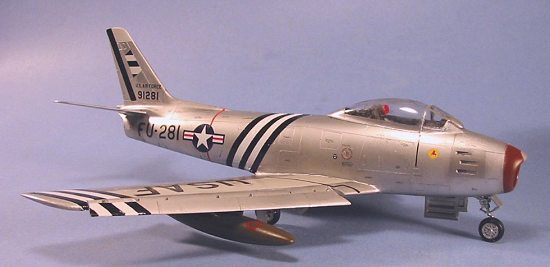 The F-86A and the
MiG-15 were similar in performance, but quite different in details. The MiG
excelled at high altitude combat, with a combat ceiling of 50,000 feet, while
the Sabre's best combat altitude was below 35,000 feet, and it was wallowing to
get over 40,000 feet. Thus, many combats began with the MiG-15 pilots deciding
to attack with a dive on the Sabres below. Sergei Karamenko, a 13-victory MiG
ace (on top of 12 WW2 victories), described combat between Sabres and MiGs thus:
"The Sabre was the most dangerous threat to my friends and I in Korean skies.
Our MiG-15 and the F-86 Sabre belonged in the same class, similar types with
similar performance. They differed only in that the MiG had an advantage in rate
of climb at altitude, while the Sabre was superior in maneuvering, especially at
low level. These advantages could not always be used, however. The fight, as a
rule, was decided in the first attack. After the first pass, we reached for
altitude, while the Sabres rushed for the ground. Each tried to reach the
altitude where it held a distinct advantage, and thus the battle faded."
The F-86A and the
MiG-15 were similar in performance, but quite different in details. The MiG
excelled at high altitude combat, with a combat ceiling of 50,000 feet, while
the Sabre's best combat altitude was below 35,000 feet, and it was wallowing to
get over 40,000 feet. Thus, many combats began with the MiG-15 pilots deciding
to attack with a dive on the Sabres below. Sergei Karamenko, a 13-victory MiG
ace (on top of 12 WW2 victories), described combat between Sabres and MiGs thus:
"The Sabre was the most dangerous threat to my friends and I in Korean skies.
Our MiG-15 and the F-86 Sabre belonged in the same class, similar types with
similar performance. They differed only in that the MiG had an advantage in rate
of climb at altitude, while the Sabre was superior in maneuvering, especially at
low level. These advantages could not always be used, however. The fight, as a
rule, was decided in the first attack. After the first pass, we reached for
altitude, while the Sabres rushed for the ground. Each tried to reach the
altitude where it held a distinct advantage, and thus the battle faded."
Many World War II aces flew Sabres during the Korean War and added to their scores. One of these was Lt. Col. Glenn T. Eagleston, the top-scoring ace of the 354th "Pioneer Mustang" Fighter Group in the ETO, who added 3.5 victories during his tour with the 4th FIW in the Spring of 1951.
|
THE KIT |
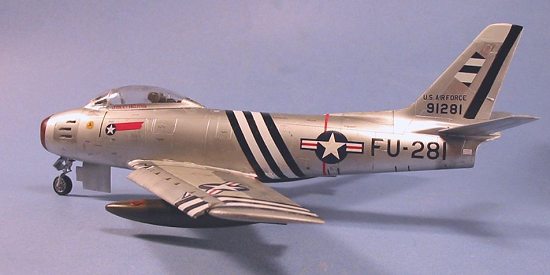 There is no model of
the F-86A or F-86E in 1/48, manufacturers having decided to concentrate on the
"definitive" Sabre (at least in USAF service), the F-86F series. The major
difference between the early Sabres and the F-86F is that the latter aircraft
has the "hard" 6-3 wing, an extended leading edge that does not have the slats
of the early versions, which improved its high altitude capabilities against the
MiG-15.
There is no model of
the F-86A or F-86E in 1/48, manufacturers having decided to concentrate on the
"definitive" Sabre (at least in USAF service), the F-86F series. The major
difference between the early Sabres and the F-86F is that the latter aircraft
has the "hard" 6-3 wing, an extended leading edge that does not have the slats
of the early versions, which improved its high altitude capabilities against the
MiG-15.
It is possible to mate the wings of the ProModeler F-86D to the fuselage of the Hasegawa F-86F, which I did back in 2001 (here is a look at that article), but that is really quite a lot of effort due to the fact that ProModeler and Hasegawa differ on what is the correct wing sweep on the Sabre. An easier conversion is to use the F-86A conversion by Cutting Edge, which provides the wing leading edge with open slats, as well as the different rear fuselage associated with the A-model Sabre as compared with the F.
|
CONSTRUCTION |
In this case, construction started with the wing. Following the instructions in the conversion set, I cut off the leading edges of the Hasegawa kit's wings. This is accomplished by cutting along panel lines, which makes things very easy indeed. I had previously cut the resin leading edge off its molding block and cleaned it up. With the plastic wing parts glued together, the resin leading edge fit perfectly, and was attached with cyanoacrylate glue.
With that over, I
turned to the fuselage. I cut the tail off the Hasegawa kit and attached the
resin rear fuselage parts, which also fit without difficulty. I did discover
when trying to glue the fuselage halves together that the backing around the
dive brake wells was too thick to allow me to mount the exhaust pipe. This was
easily solved by a few minutes' effort
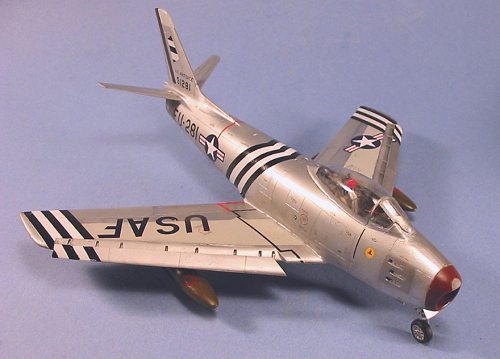 with the Dremel, grinding off the
backing. The exhaust fit easily afterwards.
with the Dremel, grinding off the
backing. The exhaust fit easily afterwards.
I had also decided to use a Jaguar resin cockpit with this kit. While the cockpit is for the F-86F, the differences between that and the F-86A cockpit are minimal - and even a Champion Picker of Nits would be unlikely to spot them. The big difference is that the cockpits of the early F-86As were painted grey, while the later production models had a black cockpit. I really like the Jaguar cockpit - the seat is excellent, with realistically-cast seat belts, and the rest of the cockpit is of equal quality. With this painted and installed, the intake trunking was attached and the fuselage was closed up. I also decided to close the canopy - it is very clear (and even more so if you Future it) and the airplane looks better closed up than with the canopy open. The Cutting Edge set provides a clear resin part for the angled windscreen of the early Sabres, which was also attached at this time after it too had been Futured.
Because the F-86A does not have the 6-3 wing, you must sand off the area of the fuselage where the leading edge of the kit wing fits, and then rescribe the area. When I finally attached the wing to the fuselage, I used some C-A glue and Mister Surfacer 500 for gap-filling along the area where the upper surface of the wing fits to the fuselage.
At this point, the model was ready for painting.
|
PAINT & DECALS |
Painting:
I first painted the spar boxes of the wings with Gunze-Sangyo "Light Gull Grey," which is a good approximation of the color of the anodized metal used there. I also painted the tip of the rudder grey, and finished off by painting the nose cone with Tamiya "Red Brown", because the particular airplane I was doing had the intake cone left in the natural color of the fiberglass it was made of. (Many people have stated that Eagleston's airplane had a red nose, but Cutting Edge calls for the brown nose on their decal sheet.)
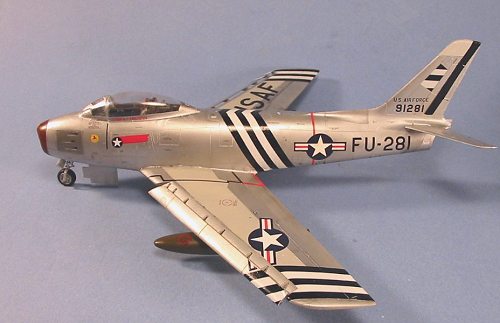 I then masked off
these areas and painted the rest of the model with SnJ Aluminum, which I use as
the base coat for multi-hue natural metal finishes, since it is impervious to
masking tape when dry.
I then masked off
these areas and painted the rest of the model with SnJ Aluminum, which I use as
the base coat for multi-hue natural metal finishes, since it is impervious to
masking tape when dry.
After the SnJ was dry, I masked off various areas of the fuselage and painted them with various hues of Testors ModelMaster Metalizer paints, which I sealed as I completed each different color.
Once all this was done, I removed the masking (which was done with drafting tape, NOT masking tape) and was ready for decals.
Decals:
First, I attached the horizontal stabilizers and glued the dive brakes in the closed position - photos show that most F-86As sat in their revetments in this condition. I also attached the leading edge slats and the landing gear at this time so the model could sit on its gear while being decaled.
I used the Cutting Edge sheet "F-86A Sabres Part 3" (CED 48-175). I also used the Cutting Edge "Sabre Stencils" sheet (CED 48-028).
This Sabre has the early black-white stripes for identification that were later replaced by the more familiar yellow stripes. The decal sheet includes the black stripes, and assumes the modeler will airbrush the white areas. I elected to use white decal sheet, and applied that first. When it had set up, I applied the black stripes and allowed them to set up. Once this was done, I applied the rest of the decals. Cutting Edge decals are very thin, and go down well under a coat of Micro-Sol.
 Once everything was
set up, I washed off the dried decal solvent, dried the model, and gave it a
light coat of Testors ModelMaster Sealer to protect the decals on the NMF
surfaces.
Once everything was
set up, I washed off the dried decal solvent, dried the model, and gave it a
light coat of Testors ModelMaster Sealer to protect the decals on the NMF
surfaces.
I then attached the drop tanks. Drop tanks made at Misawa in Japan had a different separation trajectory than those made in the States, and if the pilot was not flying "unloaded" and straight and level when he punched the tanks off, they could somersault over the leading edge of the wing and damage the fuselage or the horizontal stabilizers. So that pilots were aware of which tanks they were carrying, Misawa tanks were painted Olive Drab, which I did for this model to make it look visually different from the other Sabres in my collection.
|
CONCLUSIONS |
I now have at least one of the major sub-types of Sabre in my collection. It's too bad someone like ProModeler doesn't do an early Sabre, but till something like that happens, the Cutting Edge set is easy to use and results in a good-looking model.
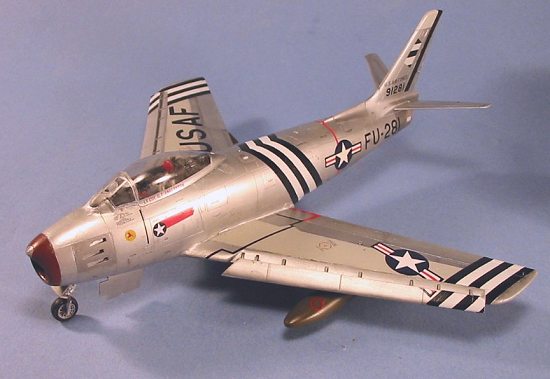 Editor's
Notes:
According to pilots, whose stories are in the new book 'Mig
Alley', the Japanese made tanks held 10 gallons less fuel than the US made
ones. That is the reason for them being painted matte olive drab. I had originally
thought it was because they were made of thicker aluminum, but apparently that
is not the case. Interestingly, they were also much less expensive with US tanks
costing at least three times as much.
Editor's
Notes:
According to pilots, whose stories are in the new book 'Mig
Alley', the Japanese made tanks held 10 gallons less fuel than the US made
ones. That is the reason for them being painted matte olive drab. I had originally
thought it was because they were made of thicker aluminum, but apparently that
is not the case. Interestingly, they were also much less expensive with US tanks
costing at least three times as much.
A couple of things that one needs to consider when doing this conversion. First of all, the F-86A-1 (47-605 to -637 and 48-129 to -319) had a curved windscreen and not the peaked one in the conversion set. Secondly, with the F-86A-5 version (49-1007 to -1339), the peaked windscreen was adopted and the gun doors removed and replaced with the 'normal' gun troughs. Be sure to check your serials for according to my reference (The North American Sabre, by Ray Wagner), you would not have the gun doors and a peaked or triangular windscreen together. The only reason I bring it up (other than being anal) is that I was looking for a picture of the plane in Tom's review (finally found one - 2012) and saw very few photos of Korean War F-86As with the gun doors, so started snooping as to why.
January 2003
Copyright ModelingMadness.com. All rights reserved. No reproduction in part or in whole without express permission.
If you would like your product reviewed fairly and fairly quickly, please contact the editor or see other details in the Note to Contributors.